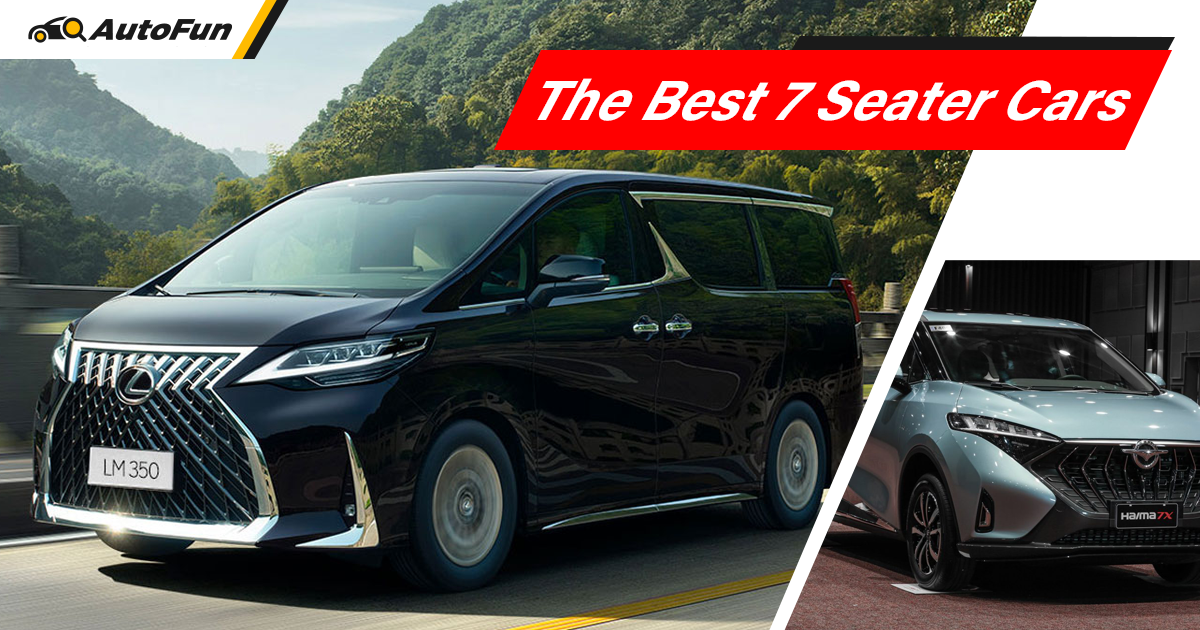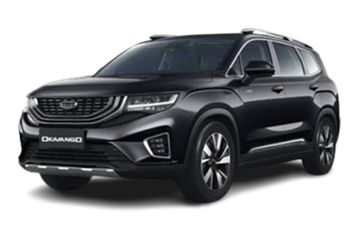Not only that but because of the modern family's versatility in income - possibly from both a steady job and a family business - the need for a larger vehicle is even more significant now.
What was called the Asian Utility Vehicle in the 90s has matured into the 7-seater Multi-Purpose Vehicle now. Gone are the days when everyone sat cramped in the back two (or sometimes three) rows. Now, it's a competition to see who can seat all seven passengers in comfort, and have the most features available not only to the driver but even to the passengers too.
Outlined here will be the market's seven best 7-seater cars, each having its own reason as to why buyers should consider them. Naturally, this isn't the only list for those looking for a big family car, but it's a list that may make you go “Man's got a point,” and with that, let's begin.
Haima 7x - ₱1,199,000
![Best 7-seater cars in the Philippines: A variety of choices when 5 seats aren't enough 01]()
Starting the list is the MPV that seems to be the most budget-friendly MPV on the market. It is by no means the cheapest - in fact, the Haima 7x is on the dear side of expensive, compared to rivals like the Ertiga and the Xpander.
Where the 7x claws back some of that value is in features and space. The Haima 7x is a spacious vehicle, with ample head and leg room for both second and third-row passengers, a pleasant deviation from the market norm. Where most vehicles trade space between the two rows to provide a modicum of trunk space, the 7x is able to provide a win-win-win scenario - great leg room and headroom for the middle row, ample space in the third row, while still having a decent-sized trunk with the third row up. One downside to the cargo space is that you can't fold the middle seats to maximize your cargo space. But there's a good reason why.
Unlike many other 7-seater cars in the Philippines at this price point, the Haima 7x offers buyers captain's seats in both the front and rear, making this a little more luxurious than most of its competitors. Trading foldable seats for comfort on both short and long journeys does sound quite worth it.
Another great feature of the 7x is the engine it comes fitted with. Powered by a 1.5-liter turbo inline-four and mated to a six-speed automatic transmission, the Haima 7x makes 164 PS and 240 Newton-meters of torque, quite a large amount for a segment where the average hangs around the 111-PS mark.
Features include Bluetooth connectivity, a large infotainment screen, an LCD instrument cluster, projector headlights, a panoramic sunroof, cruise control, as well as a host of safety systems like assisted braking, traction control, hill start, and hill descent assist, as well as an electronic cruise control system. Sadly, something missing is Apple CarPlay and Android Auto, a feature that's starting to find itself becoming more and more standard in the 7x's rivals.
Keeping all of that in mind, the Haima 7x still sounds like a well-equipped, 7-seater MPV for not much money. Definitely worth a look for expanding families who need the function, but want the form too.
Maxus G50 Premium - ₱1,338,000
![Best 7-seater cars in the Philippines: A variety of choices when 5 seats aren't enough 02]()
A step up from the Haima 7x is another Chinese offering, the Maxus G50 Premium. At ₱1,338,000, however, the G50 Premium is a lick more expensive. Whether or not that price is justified is for us to decide.
For starters, the G50 is a much taller and longer 7-seater, giving it a much more practical feel. Certainly, an MPV with as much headroom as this deserves praise, especially when it comes equipped with a panoramic sunroof as well.
The G50 is a bit of a cheater in this 7-seater cars roundup, primarily because it's billed as an 8-seater. While it is technically possible to seat two up front, three in the middle, and three in the back, it's more comfortable to seat two in the back so that they do not end up rubbing shoulders. Still, it's nice to know that, should you need an extra seat, the G50 can provide it.
The standard for the segment is a 1.5-liter inline-four gasoline engine and an automatic transmission, but the G50 is fitted with a less common 1.5-liter turbo making 169 PS and 250 Newton-meters of torque. Even less common than that is the G50's transmission - a 7-speed dual clutch transmission. It comes as no surprise, then, that the G50 premium has one of the smoothest driving dynamics around, with minimal engine vibration and nearly seamless gear changes ironing out any unwanted shaking from the engine bay.
It's with the features that the G50 starts to shine through, though. Bluetooth connectivity and a wireless charging pad are included, but no Android Auto or Apple CarPlay. Headlights and tail lights are an all-LED affair, but the Premium is the only variant of the G50 that gets automatic headlights. It also gets a power lift tailgate, as well as a six-speaker sound system, cruise control, and automatic air conditioning. Perhaps the best feature of all is the power seats that the driver and front passenger receive, making adjustments to the driving position more precise, even if at a dawdle.
Safety-wise, the G50 has come prepared. Aside from the mandatory driver and front passenger airbags, the Premium comes with side airbags for the front occupants. It also comes with Emergency Brake Assist, Hill Hold control, Traction Control, front and rear parking sensors, and a rear reversing camera with a 360-degree view.
All this ends up making the G50 Premium cost a pretty penny. Is it worth it? It definitely is.
Chery Tiggo 8 Pro PHEV - ₱2,500,000
![Best 7-seater cars in the Philippines: A variety of choices when 5 seats aren't enough 03]()
The Chery Tiggo 8 Pro may not be an MPV, but it does still have seven seats, which made it part of the pool of vehicles under consideration for this list. You may ask yourself, though, why there's such a big jump in price from the affordable Maxus and Haima, and there's now an SUV in the mix worth two and a half million Philippine pesos. The answer may surprise you.
Certainly, the Tiggo 8 Pro PHEV is nowhere near the same level of affordability as the Haima 7x or Maxus G50, but it makes up for a little bit of that extra money by being lavish and well-appointed inside. No hard plastics on any of the touch surfaces make it a pleasant place to be. And the features go on and on, from Android Auto and Apple CarPlay, all the way to adaptive cruise control. Still, many other SUVs and MPVs offer the same for much, much less.
What they don't offer, though, is a Hybrid powertrain. The Tiggo 8 Pro PHEV is powered by a 1.5-liter turbocharged inline-four, that's coupled with two electric motors and a dedicated hybrid drive transmission to develop an eye-watering 320 horsepower and 545 Newton-meters of torque. To reiterate, this is a 7-seater with more power and torque than the current car scene darling, the Toyota GR-Yaris. Typically, the Tiggo 8 Pro PHEV will not produce all that immediately. It will have on average less than half that. But it's still an interesting notion that there's a potent powertrain hiding under this otherwise unassuming body. On top of that, the Tiggo8 Pro PHEV has, in other markets around the world, achieved a staggering 80 kilometers per liter in fuel consumption.
With a 19.27-kilowatt-hour battery pack and a 45-liter fuel tank, the Tiggo8 Pro PHEV has a pure electric driving range of about 95 kilometers and a total cruising range of about 3,400 kilometers. Impressive numbers for a car that has space for the kids, the dog, and all the bits and bobs you'd need for a trip to the countryside.
Inside, the Tiggo8 Pro PHEV has luxury guaranteed dead to rights. Nappa Leather on all of the seats, suede and soft-touch plastic lining on just about every touch surface available, and a large touchscreen infotainment system, with incorporated A/C controls in the center console.
As one of the few Hybrids in the market, and the only 7-seater parallel hybrid car on the market, the Chery Tiggo 8 Pro PHEV may be expensive, but worth giving some thought.
Geely Okavango Hybrid - ₱1,503,000
![Best 7-seater cars in the Philippines: A variety of choices when 5 seats aren't enough 04]()
If the Chery Tiggo 8 Pro PHEV is too rich for your blood, then the Geely Okavango might be a more enticing (and affordable) option if you want to get into hybrid motoring. Keep in mind, however, that the Okavango Hybrid is a mild Hybrid vehicle, not a full Hybrid, unlike the Tiggo8 Pro PHEV. Still, the Okavango Hybrid does offer up to 13 kilometers per liter in the city, and 16.5 on the highway - decent numbers from a seven-seater SUV.
Apart from the difference in hybrid drive, the Okavango is also a little more down on power compared to the Tiggo. While they may have similar 1.5-liter turbocharged engines, the Okavango has to do with 192 PS and 300 Newton-meters of torque, a little over half of what the Tiggo8 Pro PHEV makes. While not as rapid, the Okavango is still no slouch, making every bit of that power count through a 7-speed DCT.
Inside, the Okavango has quite a bit more hard plastic to make it more family-friendly. No Android Auto or Apple CarPlay, but you still get Bluetooth connectivity, 360-degree camera, and a sizable 12.3-inch infotainment screen. Something of note for the Okavango is that it doesn't use the usual 7-seater car layout, instead opting to give each passenger their own adjustable seat. While quirky, the feature does allow for the creation of very unique seating arrangements, as well as an endlessly customizable amount of legroom in the vehicle. Useful? Very much so.
All in all, the Okavango is pretty run-of-the-mill in the 7-seater SUV segment cars, but it's good where it matters - ride comfort and value for money. It's not every day you find a unibody SUV that rides so smoothly on highways, especially not for the price the Okavango commands. Taking that and all of its other features and benefits into account, this SUV should work well for any application it may be used for.
Lexus LM350 - ₱5,628,000
![Best 7-seater cars in the Philippines: A variety of choices when 5 seats aren't enough 05]()
If you thought ₱2,500,000 was steep, you've seen nothing yet.
The Lexus LM350 is, in this country at least, the pinnacle of mass-produced luxury.
Based on the already ultra-luxe Toyota Alphard, the LM350 takes things up a notch with seats that feel like they're more suited to a Gulfstream G280 private jet. Massage functions and full reclining ability are only the tip of the iceberg with this model. The 7-seater LM350 has ventilated seats for the first four occupants - yes, driver included - and while we're not counting the 4-seater variant, it does get a chauffeur's partition as standard - yes, STANDARD. Discussing stock prices and business decisions on the move can be so comfortable once the massagers are on and the seats are reclined, and once you and your assistant finish discussing and decision-making, a bottle of bubbly awaits you in your refrigerator. So sit back, put on the latest episode of Bling Empire on your 13.3-inch entertainment screen, and relax as you laugh at the poor folk running around in haute couture through the streets of Paris. Even getting in and out of the LM350 is an event in itself, as the automatic doors welcome you into their warm embrace. And almost as quickly as they open, they close to cocoon you away from the hustle and bustle of Manila traffic.
Not that it matters to you as a business magnate, but the LM350 smoothly accelerates, thanks to Toyota's bulletproof 3.5-liter V6 engine and 8-speed automatic transmission, making 301 PS and 361 Newton-meters of torque. But truly, all you need to know is that Lexus has gone to painstaking lengths to make any and all vibrations and noises coming from the engine disappear. Fuel consumption? That's something you needn't concern yourself with if you're considering this Lexus.
Strictly speaking, if you're reading this list, then you're not really in the market for a Lexus LM350. But we dare to dream, right? If you are though, would you mind taking us along with you on your daily commute? Pretty please?
Kia Carnival - ₱2,068,000 - ₱3,088,000
![Best 7-seater cars in the Philippines: A variety of choices when 5 seats aren't enough 06]()
Coming down from the LM350, we have the Kia Carnival. If you need time to get over the pipe dream of owning and sitting in the Lexus luxo-barge, take a minute and come back to this one. Are you with us now? Ok, let's continue.
The Kia Carnival is Kia's answer to its own Kia Sorento. No longer called a van, this Grand Utility Vehicle is positioned as a crossover between a van and an SUV - a crossover no one really thought about since now.
Powered by Kia's Smartstream 2.2-liter inline-four turbodiesel, and mated to the Smartstream 8-speed automatic transmission, the Carnival puts out 202 PS and 440 Newton-meters of torque. “Sufficient” is a good word to describe the performance of the Carnival, in that it can definitely get up and go, but no one's getting pinned to their seat. Fuel consumption is par for the course, getting 8 kilometers per liter in the city, and 22 on the highway.
Upfront, the Carnival gets a premium-feeling dashboard, with an integrated 8-inch infotainment touchscreen. Apple CarPlay and Android Auto come standard, and the top-of-the-line SX version comes with Blind Spot Monitoring, Rear Cross-Traffic Alert, parking sensors, reversing camera, a slew of airbags, and power seats for the driver and front passenger.
In the middle, the more expensive SX variant gets power relaxation seats, which are power reclining and cooled, for that extra level of comfort for the middle passengers.
One thing the Kia Carnival does very well, though, is cargo space. The cavernous rear has a cargo volume of 1000 Liters with the rear seats up, and 2000 Liters with them down and stowed away.
In short, if you aren't a business magnate, but simply want to waft down EDSA in comfort and simple serenity, then the Carnival is a good choice.
Toyota Innova - ₱1,370,000 - ₱1,779,000
![Best 7-seater cars in the Philippines: A variety of choices when 5 seats aren't enough 07]()
Possibly the most popular vehicle in the Philippines, the Toyota Innova is enjoying nearly 15 years of market domination in the Philippine MPV market, which actually spans closer to 45 years, if the Tamaraw and Revo count as well. The recipe for the Innova's success couldn't be simpler - 7 spacious seats, 2.8-liter diesel power, and a ruggedness that couldn't be matched thanks to the fact that it sits on the same frame as the Hilux pickup and Fortuner SUV.
It was the go-to 7-seater MPV car for families who ran a business together, and it was a favorite among fleet buyers because of that same versatility. The folding seats and spacious cargo bay made it capable of taking huge volumes of items, and its body-on-frame construction meant that it could also take the weight.
The second generation Innova will actually be the last body-on-frame Innova, as the model will migrate to a new, unibody platform, ditching even the venerable diesel engine it's become synonymous with for a 2.0-liter gasoline engine and a hybrid powertrain. Only time will tell if this coming generation will appeal to the same buyers as the current one does.
Currently, though, the Innova is powered by a 2.8-liter inline-four turbodiesel engine mated to a six-speed automatic or five-speed manual transmission, making either 170 or 174 PS and either 343 or 360 Newton-meters. On average, the Innova has a fuel consumption of about 9-13 kilometers per liter in the city, and at least 18 on the highway. A little on the low side, especially when the rest of this list can do 20, but it's not overly poor performance.
Inside, the Innova is every bit the utilitarian workhorse you expect it to be. Easy to clean fabric seats for all seven occupants, no power seats here, and nor do you get cruise control. Android Auto and Apple CarPlay are available on most trim levels, but you only get Bluetooth connectivity on the basic J variant. Reversing cameras and parking sensors are only available on the top V and G variants, while the E and J have only the driver's skill.
The Innova was never meant to win “Best in Features” awards, or wow audiences with its amazing audio quality. It was brought into this world for one purpose only - to carry the whole family until the world ends. And it can do that, as it has always done in the past, and will continue to do so in the future.













